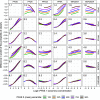Associations of Prenatal Per- and Polyfluoroalkyl Substance (PFAS) Exposures with Offspring Adiposity and Body Composition at 16-20 Years of Age: Project Viva
- PMID: 38054701
- PMCID: PMC10699168
- DOI: 10.1289/EHP12597
Associations of Prenatal Per- and Polyfluoroalkyl Substance (PFAS) Exposures with Offspring Adiposity and Body Composition at 16-20 Years of Age: Project Viva
Abstract
Background: Findings on the associations between prenatal PFAS exposures and offspring adiposity are inconsistent. Whether such associations may extend to adolescence is especially understudied.
Objectives: We investigated associations of prenatal PFAS exposures with offspring adiposity and body composition at 16-20 years of age.
Methods: We studied 545 mother-child pairs in the prospective prebirth cohort Project Viva (Boston, Massachusetts). We measured six PFAS (PFOA, PFOS, PFNA, PFHxS, EtFOSAA, and MeFOSAA) in maternal early pregnancy (, range: 5.7-19.6 wk) plasma samples. At the late adolescence visit ( y, range: 15.9-20.0 y), we obtained anthropometric measures and assessed body composition using bioelectrical impedance analysis and dual-energy X-ray absorptiometry. We examined associations of individual PFAS with obesity [i.e., age- and sex-specific body mass index (BMI) percentile] and adiposity and body composition using multivariable Poisson and linear regression models, respectively. We assessed PFAS mixture effects using Bayesian kernel machine regression (BKMR) and quantile g-computation. We used fractional-polynomial models to assess BMI trajectories (at 3-20 years of age) by prenatal PFAS levels.
Results: Thirteen percent () of the children had obesity in late adolescence. After multivariable adjustment, higher prenatal PFAS concentrations were associated with higher obesity risk [e.g., 1.59 (95% CI: 1.19, 2.12), 1.24 (95% CI: 0.98, 1.57), and 1.49 (95% CI: 1.11, 1.99) times the obesity risk per doubling of PFOS, PFOA, and PFNA, respectively]. BKMR showed an interaction between PFOA and PFOS, where the positive association between PFOS and obesity was stronger when PFOA levels were lower. Each quartile increment of the PFAS mixture was associated with 1.52 (95% CI: 1.03, 2.25) times the obesity risk and 0.52 (95% CI: , 1.06) higher BMI. Children with higher prenatal PFOS, EtFOSAA, and MeFOSAA concentrations had higher rates of BMI increase starting from 9-11 years of age.
Discussion: Prenatal PFAS exposures may have obesogenic effects into late adolescence. https://doi.org/10.1289/EHP12597.
Figures





Comment on
-
Invited Perspective: Long-Term Effects of Gestational PFAS Exposures on Adiposity-Time for Solutions.Environ Health Perspect. 2023 Dec;131(12):121301. doi: 10.1289/EHP13966. Epub 2023 Dec 6. Environ Health Perspect. 2023. PMID: 38054702 Free PMC article. No abstract available.
References
-
- Fryar CD, Carroll MD, Afful J. 2020. Prevalence of overweight, obesity, and severe obesity among children and adolescents aged 2–19 years: United States, 1963–1965 through 2017–2018. NCHS Health E-Stats. https://www.cdc.gov/nchs/data/hestat/obesity-child-17-18/obesity-child.htm [accessed 4 November 2022].

